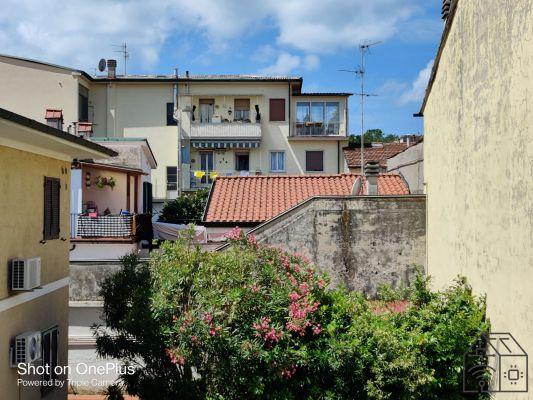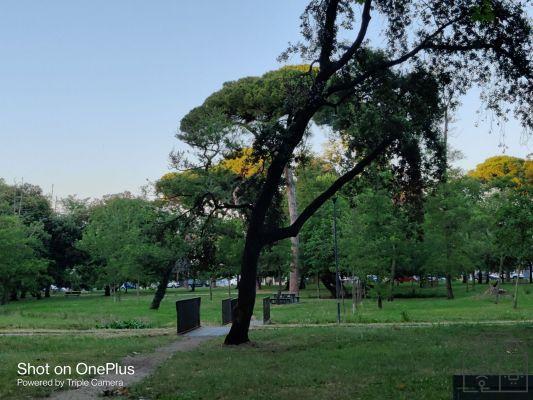
OnePlus 8 review
When OnePlus unveiled its new 8 series in April, the world was certainly in a darker time than the current one. Nonetheless, the company, famous for its very direct relationship with its customers and its community of enthusiasts, has managed to generate hype and excitement around this launch, enhancing the speed, the fluidity and solidity of the two devices. Now after trying the younger brother for a while OnePlus 8, we are ready to give you our review and our impressions about it. (For those interested in an opinion on the version Pro, find our preview test at this link).
OnePlus 8: a solid choice for everyone
If there is one word that could define this device, it surely would be performance. OnePlus 8 indeed incorporates all the specifications necessary to make it a real one top in gamma: in fact, we find the processor inside Qualcomm Snapdragon 865 and the GPU Adreno 650, supported by 8 o 12 GB of RAM LPDDR4X e 128 o 256 GB of storage UFS 3.0 2-LANE. These last two features in particular ensure that the data flow needed for open an application o load a game is extremely fast, with therefore waiting times extremely reduced.
This 'hardware' speed drives to the operating system OXYGEN (based on Android 10) and to the screen with a refresh rate of 90 Hz, guarantees the fluidity and the reactivity to which OnePlus has accustomed its users over the years, in a guise that is still renewed and improved here.
 Then there are other aspects in which OnePlus is 'fast', such as the connectivity (thanks to the support to 6 WiFi and 5G) and the recharge. For the latter there is technology Warp Charge 30T Fast Charging, available in series thanks to the charger included in the package. Allows you to load, according to our tests, most of 50% of the battery in just half an hour. And we are talking about a very large battery (4300 mAh), able to easily get the phone to the end of the day and beyond. Too bad for the lack charging wireless, reserved for the Pro model together with the 4510 mAh.
Then there are other aspects in which OnePlus is 'fast', such as the connectivity (thanks to the support to 6 WiFi and 5G) and the recharge. For the latter there is technology Warp Charge 30T Fast Charging, available in series thanks to the charger included in the package. Allows you to load, according to our tests, most of 50% of the battery in just half an hour. And we are talking about a very large battery (4300 mAh), able to easily get the phone to the end of the day and beyond. Too bad for the lack charging wireless, reserved for the Pro model together with the 4510 mAh.
And OnePlus 8 Pro? Click here to find out how it behaves
Beautiful aesthetics, beautiful screen
Using OnePlus 8 daily means first of all having to deal with its size and its handling. It is in fact a phone with an important footprint (even if smaller than the Pro), with a diagonal of well 6.55" inches. The weight of almost due (180g) is instead surprisingly contained, and is also well balanced.
Both the front and the back are covered with Corning Gorilla Glass 5 curved, an extremely resistant type of glass. Handling it, however, would not suggest that both sides are covered with the same material. The satin finish on the back makes it possible not to leave fingerprints and to have a feeling smooth e soft to the touch.
 Moving on to the already mentioned front side, we find a screen Fluid AMOLED 1440p with incorporated one fingerprint sensor. The aspect ratio 19,8: 9, elongated but not excessively, it allows a good grip. The AMOLED display instead guarantees an excellent color rendering and contrasts deep, thanks also to the support a HDR10 +. On the other hand, however, the brightness, even at its maximum, is not very high, making it difficult to use in direct light. Finally, the aforementioned 90 Hz refresh rate returns an extremely smooth interface navigation experience.
Moving on to the already mentioned front side, we find a screen Fluid AMOLED 1440p with incorporated one fingerprint sensor. The aspect ratio 19,8: 9, elongated but not excessively, it allows a good grip. The AMOLED display instead guarantees an excellent color rendering and contrasts deep, thanks also to the support a HDR10 +. On the other hand, however, the brightness, even at its maximum, is not very high, making it difficult to use in direct light. Finally, the aforementioned 90 Hz refresh rate returns an extremely smooth interface navigation experience.
 This refresh rate also comes into play in other aspects of the user experience, such as gaming. In fact, more and more Android games support a higher refresh rate than the classic 60 Hz. Titles such as Brawl Stars in this way they have a new level of enjoyment, thanks to the synergy of frame rate and high resolution screen. On the other hand, the anticipated 90 Hz experience in Fortnite, which at the moment can exploit this frame rate exclusively on OnePlus devices. It is in fact possible to achieve this value only at the cost of setting the graphics to minimum and accepting a fast overheating of the phone (with consequent consumption of the battery). In short, technically it is possible, but perhaps not preferable to the classic 60 Hz.
This refresh rate also comes into play in other aspects of the user experience, such as gaming. In fact, more and more Android games support a higher refresh rate than the classic 60 Hz. Titles such as Brawl Stars in this way they have a new level of enjoyment, thanks to the synergy of frame rate and high resolution screen. On the other hand, the anticipated 90 Hz experience in Fortnite, which at the moment can exploit this frame rate exclusively on OnePlus devices. It is in fact possible to achieve this value only at the cost of setting the graphics to minimum and accepting a fast overheating of the phone (with consequent consumption of the battery). In short, technically it is possible, but perhaps not preferable to the classic 60 Hz.
A good but not perfect photographic department
So far we have overlooked the photographic performance of this device, but now is the time to talk about it with a dedicated section. Let's start with the technical specifications: on the back we have a main sensor Sony IMX586 da 48MP, flanked by a ultra-wide-angle da 16MP (field of view 116°) and a goal macro da 2MP. On the front we find a sensor instead Sony IMX471 da 16MP for selfies embedded in a photo in the glass.
 The main sensor is an old acquaintance, as it is already present on the series OnePlus 7. It is normally used in mode 4 in 1, that is, the small pixels of the sensor are joined in groups of four to form normal-sized pixels and take pictures from 12 MP. This guarantees very bright and resolution-consistent photos with wide-angle photos.
The main sensor is an old acquaintance, as it is already present on the series OnePlus 7. It is normally used in mode 4 in 1, that is, the small pixels of the sensor are joined in groups of four to form normal-sized pixels and take pictures from 12 MP. This guarantees very bright and resolution-consistent photos with wide-angle photos.
 The phone also takes advantage of this “resolution availability” to take zoomed photos x2 at native resolution of 12MP. These photos, however, are not technically better (except in terms of shutter speed) than those you would get by shooting in mode. 48MP and cropping the result.
The phone also takes advantage of this “resolution availability” to take zoomed photos x2 at native resolution of 12MP. These photos, however, are not technically better (except in terms of shutter speed) than those you would get by shooting in mode. 48MP and cropping the result.
The limited usefulness of this 'fake' zoom is made even more evident by the lack of a telephoto dedicated, present instead in OnePlus 7 Pro, OnePlus 7T and also OnePlus 8 Pro. Instead, we have a goal macro, much less useful and versatile, especially at this resolution.
The photographic software is instead very solid and well built, starting from the mode Pro, complete with modality RAW and manual control of every aspect, passing through small goodies such as modes Time-Lapse e Slow-Motion. The video mode is also very good, with support for the 4K 60fps and the stabilization mode Super Stable.








OnePlus 8 review: the smartphone for those who need to update
Given all the features we've seen so far, who is this phone suitable for? First of all, it is a must for those who are already passionate about OnePlus products. This category of people, however, could be more interested, mainly for the photographic department and for wireless charging, in the Pro model. In any case, it is probably not worth switching to either of these two devices if you already have a OnePlus 7 Pro o 7T, because compared to both improvements they are decidedly marginal.
OnePlus 8, on the other hand, represents an interesting choice for anyone who currently has a phone that is a few years old and is about to have to change it. This device, in fact, more than others offers a very combination of specifications solid and in some cases unique, at least as far as the speed, and is therefore the perfect choice for anyone looking for a phone that truly “makes it heard in 2020”. It is not the best option for those who want a device with certain strong features, such as a professional photographic department, but even in its 'weaknesses' this phone will be of good quality for most people.
A allows this positioning is also a price certainly higher than a mid-range or even other OnePlus models of the past years, but still lower than many recently released flagships: we are talking about €719 for the model with 8GB of RAM and 128GB internal memory (available in the colors Onyx Black, Glacial Green e Interstellar Glow) is €819 for the model with 12GB of RAM and 256GB internal memory (available only in the color Glacial Green). A price that many people will consider, in a subjective and legitimate way, high, but which is fully justified by a lot of value.

OnePlus 8
Pro 
- Fast and fluid in use
- Quick charge
- Battery that lasts a long time
- Smooth 90Hz screen that's beautiful to look at
- Solid camera
Cons 
- No wireless charging
- The screen could be brighter
- No telephoto lens


























